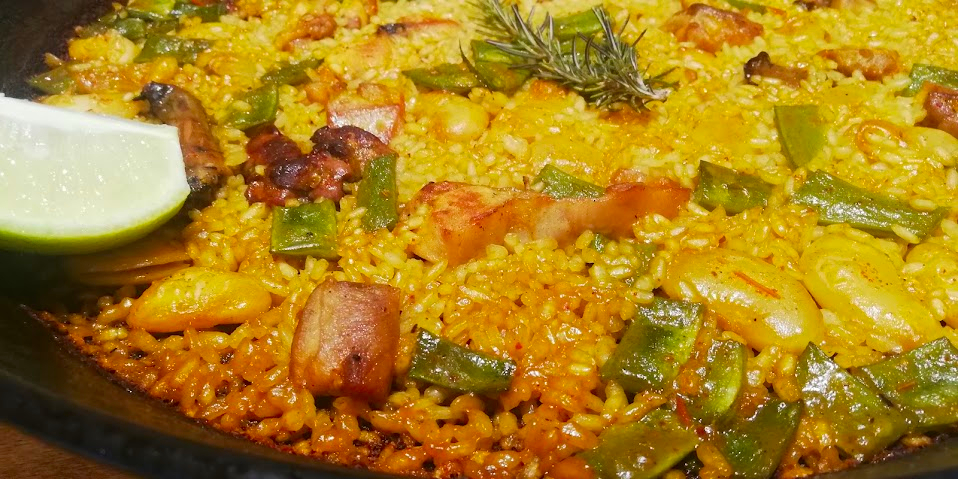
The Valencian paella – once known simply as “Arroz a la Valenciana” (“Valencian Rice”) – is a dish best enjoyed in the company of friends and family. Traditionally, it was a simple lunchtime meal for those who worked in the fields around Valencia, the ingredients being whatever could be found around the rice fields – tomatoes, onions, snails, rabbit or duck, maybe even some chicken. Some early recipes included water vole as one of the main ingredients, particularly those cooked next to the Albufera.
These days, the purists insist that Valencian paella uses just seven main ingredients: rice, rabbit, chicken, butter beans (‘garrafó’), flat green beans (‘judía ferradura’), tomatoes to which is added saffron, water and salt. Some might accept paprika or garlic; others might insist on adding snails or duck. But they all agree on one thing: an authentic Valencian paella does not contain any seafood or fish.
The best Valencian paellas are cooked over an open fire which is fuelled by wood cut from the orange tree that produces a smoke which infuses the paella with a distinctive aroma. This open fire is also the best method to create the layer of roasted rice at the bottom of the pan which is called “socarrat”, considered ‘black gold’ by Valencians who seek it out and consider it a positive characteristic of an authentic Valencian paella.
Speak to many Valencians and they will say that the paella is best eaten directly from the pan with a spoon as a communal lunchtime dish. And not any old spoon as it should be a flat wooden spoon and some more traditional restaurants provide such a utensil to those who request it. Eating paella with a fork is a gastronomic faux pas that would be frowned upon in many places.
Of course, eating direct from the pan is not as simple as it sounds and there is a strict etiquette to doing so.
First, imagine the paella as a round of soft cheese divided into mini portions. The diners should be sitting around the paella in front of one of these imaginary portions and it’s a good idea not the place two people with big appetites next to each other. Sometimes, people dig a small trench, known as a “cavallonet” to mark out their portion. The pan is never rotated and it is considered very poor taste to do so.
Before starting, some diners might want to squeeze a few drops of lemon onto their portion, but it is polite to ask the neighbours for their approval just in case some of the squeezed lemon sprays onto their portions. However, traditionally, the lemon was primarily used to remove grease from the fingers at the end of the meal.
It was tradition to wait for the host to announce the start of eating with the phrase “Vinga que es gela l’arròs” (“Come on, the rice is getting cold!”). Using a spoon (remember: never a fork), the diners eat their portion from the outer edge and move towards the centre. If someone ‘invades’ their neighbour’s portion, they may receive the swift response of “Xé!” (“Hey!”) or “Fes el favor!” (“Do me a favour!”). Continued invasion into another portion might attract the more forceful response ““Eres poc fill de puta!” (“You S.O.B!”) although these apparent insults are never more than jovial banter.
Another fine tradition is that if the pan is unstable and moves around whilst the diners are eating, a volunteer will offer to hold one of the handles to keep it still and the others must make sure that his drink is kept topped up throughout the meal.
Healthy conversation normally accompanies the meal, and it was tradition to praise the chef every two spoonfuls with comments such as “T’ha eixit ben senceret l’arròs” (“Your rice has turned out well”) or “Cague en la mare que et va parir, això està rebó” (“We praise your mother for teaching you how to cook paella so exquisitely”).
As the diner enjoys their portion of paella, any pieces of vegetable or meat that they don’t want to eat should be placed in the centre so that others may take them if they so wish. However, once a piece of meat has been removed from the pan, it can never be placed back in the pan.
When the diner has had his fill of paella, tradition dictates that they rest their spoon on the side of the pan with the announcement “Estic fart, ja no puc més” (“I’m full, I can’t eat anymore”). This gives their neighbour licence to invade what remains of the diner’s portion, crossing that imaginary boundary and consuming what’s left.
The meal ends when everyone steps away from the pan or when there is nothing left to eat, an undisputable sign of a good paella.
The traditional dessert is either melon or watermelon during the summer and oranges during the rest of the year.
According to the 2023 edition of the Wikipaella Guide, the best restaurant to enjoy an authentic Valencian paella in Xàbia (as well as other traditional rice dishes) is MEZQUIDA Restaurante in Carretera del Cap de la Nao-Pla which offers paellas cooked over a wood fire. The guide also lists Restaurante AMARRE 152 (Puerto de la Fontana, L’Arenal), Restaurante AZORÍN (Calle Toni Llido, Duanes de la Mar), LA CANTINA DE JÁVEA (Port de Xàbia) and LA PERLA DE JÁVEA (Avenida de la Libertad, Playa del Arenal) as ‘Distinguished Restaurants’ in the world of paella.
Finally, chorizo does not belong in paella of any type, let alone in a Valencian paella. Present such an ingredient and Valencians will tell you quite forcefully that you have cooked “arroz con cosas” (“rice with things”) rather than a paella. Spanish author Josep Pla i Casadevall wrote that “the abuses committed in the name of Paella Valenciana are excessive – an absolute scandal.” Jamie Oliver – take note.
Sources:
Wikipaella.org
Guia Wikipaella 2023
Wikipedia – Paella
Paella Recipes – Authentic Spanish Paella Valenciana
